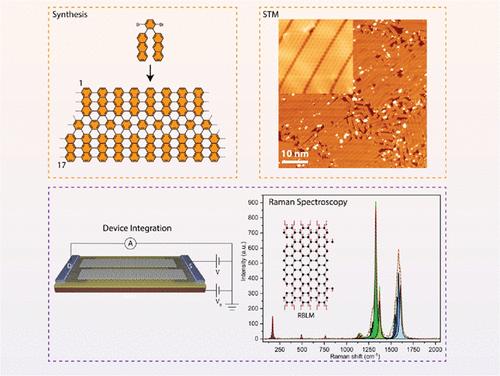17原子宽扶手型长石墨烯纳米带的优化合成与器件集成
IF 16
1区 材料科学
Q1 CHEMISTRY, MULTIDISCIPLINARY
引用次数: 0
摘要
17个碳原子宽的扶手椅石墨烯纳米带(17-AGNRs)由于其窄的电子带隙而成为高性能电子器件的有希望的候选者。通过在超高真空(UHV)中定制分子前体的自下而上表面合成(OSS)方法,可以实现边缘结构和宽度控制的原子精度。该合成协议必须进行优化,以满足器件集成的结构要求,其中条带长度是最关键的参数。在这里,我们报告了优化的OSS条件,产生平均长度为~ 17 nm的17- agnr。这种长度的增强是通过在延长的退火期间逐渐升温,以及在高表面覆盖率下单体组装驱动的类似模板的效果来实现的。利用扫描探针技术和拉曼光谱在特高压下对所得的17- agnr进行了全面表征。衬底转移后的拉曼测量能够表征器件衬底上gnr的长度分布,并确认其在环境条件和恶劣化学环境下的稳定性,包括酸蒸气和腐蚀剂。17- agnr的长度和环境稳定性的增加使其能够可靠地集成到器件架构中。作为概念验证,我们将17- agnr集成到具有石墨烯电极的场效应晶体管(fet)中,并确认电子输运通过gnr发生。这项工作证明了将窄带隙gnr集成到功能器件中的可行性,并有助于推进碳基纳米电子学的发展。本文章由计算机程序翻译,如有差异,请以英文原文为准。

Optimized Synthesis and Device Integration of Long 17-Atom-Wide Armchair Graphene Nanoribbons
Seventeen-carbon-atom-wide armchair graphene nanoribbons (17-AGNRs) are promising candidates for high-performance electronic devices due to their narrow electronic bandgap. Atomic precision in edge structure and width control is achieved through a bottom-up on-surface synthesis (OSS) approach from tailored molecular precursors in ultrahigh vacuum (UHV). This synthetic protocol must be optimized to meet the structural requirements for device integration, with the ribbon length being the most critical parameter. Here, we report optimized OSS conditions that produce 17-AGNRs with an average length of ∼17 nm. This length enhancement is achieved through a gradual temperature ramping during an extended annealing period, combined with a template-like effect driven by monomer assembly at high surface coverage. The resulting 17-AGNRs are comprehensively characterized in UHV by using scanning probe techniques and Raman spectroscopy. Raman measurements following substrate transfer enabled the characterization of GNRs’ length distribution on the device substrate and confirmed their stability under ambient conditions and harsh chemical environments, including acid vapors and etchants. The increased length and ambient stability of the 17-AGNRs led to their reliable integration into device architectures. As a proof of concept, we integrate 17-AGNRs into field-effect transistors (FETs) with graphene electrodes and confirm that electronic transport occurs through the GNRs. This work demonstrates the feasibility of integrating narrow bandgap GNRs into functional devices and contributes to advancing the development of carbon-based nanoelectronics.
求助全文
通过发布文献求助,成功后即可免费获取论文全文。
去求助
来源期刊

ACS Nano
工程技术-材料科学:综合
CiteScore
26.00
自引率
4.10%
发文量
1627
审稿时长
1.7 months
期刊介绍:
ACS Nano, published monthly, serves as an international forum for comprehensive articles on nanoscience and nanotechnology research at the intersections of chemistry, biology, materials science, physics, and engineering. The journal fosters communication among scientists in these communities, facilitating collaboration, new research opportunities, and advancements through discoveries. ACS Nano covers synthesis, assembly, characterization, theory, and simulation of nanostructures, nanobiotechnology, nanofabrication, methods and tools for nanoscience and nanotechnology, and self- and directed-assembly. Alongside original research articles, it offers thorough reviews, perspectives on cutting-edge research, and discussions envisioning the future of nanoscience and nanotechnology.
 求助内容:
求助内容: 应助结果提醒方式:
应助结果提醒方式:


